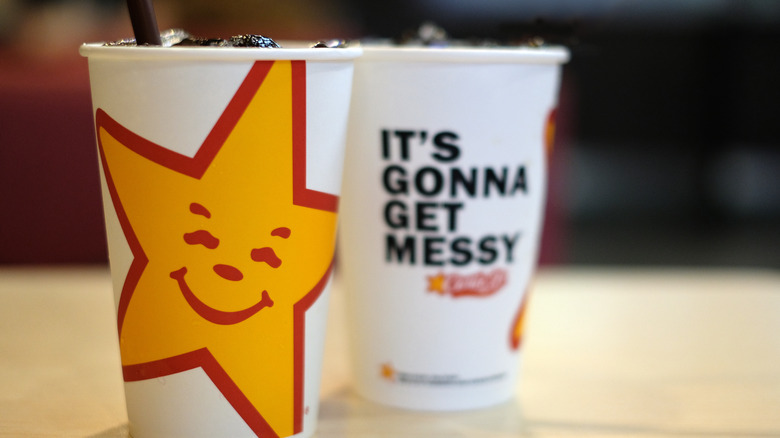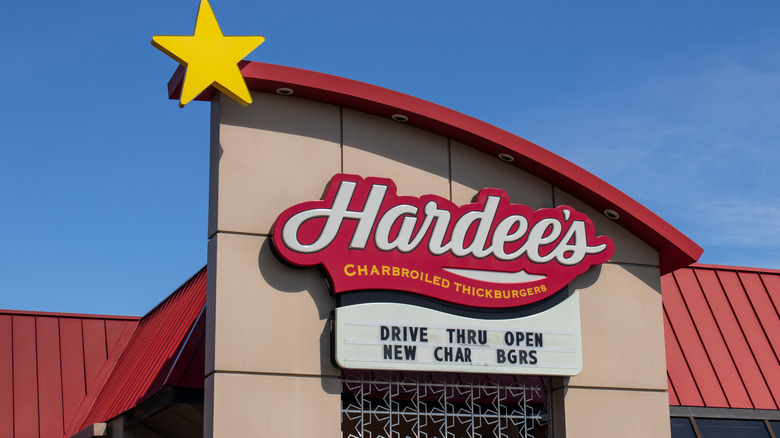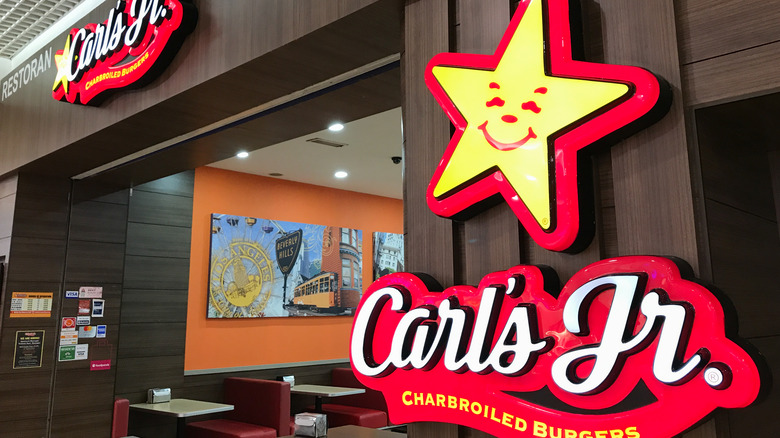When Did Carl's Jr. And Hardee's 'Break Up?'
Have you ever been to Carl's Jr.? Or have you been to a Hardee's? If you've been to either one (or even both!), you probably notice striking similarities between the two hamburger joints. For many people, the only real difference between Carl's Jr. and Hardee's is that they have different names, with everything else being more or less the same between them. How does that work, you may wonder? And for that matter, what do we mean when we say Carl's Jr. and Hardee's have "broken up?"
To get to the bottom of this mystery, we must first draw a connection between two different events in history. In 1941, PR Newswire tells us, a California man named Carl Karcher and his wife Margret mortgage their Plymouth Super Deluxe to open a hot dog stand, later moving to Anaheim to open a popular barbeque and hamburger restaurant called "Carl's Drive-In Barbeque." In 1960, in North Carolina, a man named Wilbur Hardee opens his own hamburger restaurant, which quickly grows to a modest but no less impressive 200 restaurants (via Hardee's history). According to WRAL News, Carl's Jr. acquired the Hardee's brand in 1997 for a cool $327 million, thus merging what were once two separate companies into one distinct, almost shockingly similar entity that today we knew as "Carl's Jr and Hardee's."
But what exactly were the differences, if any, between these two companies? What exactly would cause these companies to suddenly "break apart" years later after the merger?
Carl's Jr. and Hardee's were similar, but distinct
While Carl's Jr. and Hardee's are similar in many aspects, both brands have their own distinct characteristics that help to keep them from feeling too much like the other. Think of it like siblings — similar but not identical, each with their own personality.
According to Thrillist, Carl's Jr. is more of the "wild child" of the two while Hardee's, in comparison, leans more towards being "traditional" and "American." Carl's Jr offers up oversized hamburgers slathered in hot sauce, fried jalapeno poppers, and breakfast burritos while Hardee's has a menu of biscuits (made in-house, of course), chicken, and other Southern-oriented foods. Customers at Carl's Jr. are younger, rowdier, and listen to electronic dance music while Hardee's caters to a somewhat older crowd who love football and country music (via Thrillist).
It's not just the food and the types of customers that set Carl's Jr. and Hardee's apart. In 2018, FOX News tells us, Hardee's tried to distance itself from Carl's Jr.'s "provocative" advertising– you know, the ones with Kate Upton in a bikini while eating giant hamburgers? In contrast to Carl's Jr.'s racy ads, Hardee's tried to focus more on being "wholesome" (at least compared to what was going on at Carl's Jr.'s), aiming to build an image of "America's Heartland," or a cleaner and more "authentic" image (via USA Today).
It's not so much that Carl's Jr. and Hardee's "split up" in the sense that they were going their separate ways, but instead are trying to focus on different demographics.
Carl's Jr. and Hardee's build off each other's weaknesses
Let's recap what we know so far. Carl's Jr. is racy, "shocking" and exciting, has radical attitudes, and an ever-changing menu that emphasizes ridiculousness while Hardee's is more of the traditional, classic Southern foods that rely on Americana-style imagery. You have the rebellious twin and the traditional twin. But like any set of twins, although they are different in some ways, that doesn't mean they can't have a positive relationship.
Consumer Reports explains that, unlike Carl's Jr., Hardee's is more well-known for its impressive breakfast menu while Carl's Jr. has a much better lunch and dinner menu. Through the merger in 1997, Hardee's would get the benefit of Carl's Jr.'s expansive lunch menu while Carl's Jr. could cover its own breakfast menu with Hardee's. In a way, it was the two restaurants playing off each other's flaws and building on their respective strengths.
Another benefit is that both chains have established territory on both sides of the United States. As Mental Floss tells us, Carl's Jr. covers the West Coast while Hardee's covers most of the East Coast and South, ensuring that the parent company is operating across the board. Carl's Jr wouldn't be able to market towards the Alabama crowd just as Hardee's couldn't market towards the Washington crowd.
While both companies may have "split" regarding how they do things (like advertising), like most brothers, they still seem to balance each other despite their differences.


